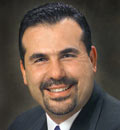Top 10 Countdown/CMS
Are your systems ready for school?
 Elias Eldayrie is turned on to tuning up operational effectiveness of IT systems and services. As associate VP for Information Technology, Eldayrie is responsible for heading up the overall operational functions of the Computing and Information Technology (CIT) unit of the University at Buffalo, State University of New York, as well as for developing and implementing strategic, tactical, and operational plans for IT on campus. Eldayrie also chairs the Administrative Systems Advisory Board, which prioritizes IT administrative projects for the campus. And as team leader of the UB2020 IT Strategic Transformation Initiative, he is leading the effort to transform the delivery of IT services, define an IT governance structure and process, and develop a funding strategy for IT. Here, he turns his operational savvy to the course management system and leads us through his 10 requirements for readiness.
Elias Eldayrie is turned on to tuning up operational effectiveness of IT systems and services. As associate VP for Information Technology, Eldayrie is responsible for heading up the overall operational functions of the Computing and Information Technology (CIT) unit of the University at Buffalo, State University of New York, as well as for developing and implementing strategic, tactical, and operational plans for IT on campus. Eldayrie also chairs the Administrative Systems Advisory Board, which prioritizes IT administrative projects for the campus. And as team leader of the UB2020 IT Strategic Transformation Initiative, he is leading the effort to transform the delivery of IT services, define an IT governance structure and process, and develop a funding strategy for IT. Here, he turns his operational savvy to the course management system and leads us through his 10 requirements for readiness.
Want to be considered for Campus Technology’s Top 10? Send your countdown and a brief background/bio summary to [email protected]
- 10
-
Make sure you have documentation for the full system.
- This means not only the system provider’s documentation, but documentation for all tools, updates, and any course-specific applications.
- Don’t forget to update key information about the owners of courses: In other words, “Who ya gonna call?”
- 9
-
Maintain staging and test servers to help you manage updates and changes seamlessly.
- Ensure that any change to your environment g'es through an acceptance testing process.
- Use the test server to prototype and model changes, and the staging server for acceptance testing.
- 8
-
Practice good change management.
- Make sure all changes to your configuration are logged, and that a rollback procedure is in place.
- If something g'es wrong, the first question should be, “Exactly what changed?”
- 7
-
Understand how many courses and users have been added between semesters.
- Verify these numbers with the owners of the courses.
- Make sure you have enough hardware to handle the increase in usage.
- 6
-
Know your logs!
- Enterprise applications have a number of error and system logs; locate and learn how to use them.
- Be sure to regularly monitor the logs for unusual events.
- 5
-
Create backups daily and be ready to use them.
- Monitor your environment actively.
- Practice restore procedures regularly, using the test server.
- 4
-
Purge courses and records that are no longer in use.
- Remember, keeping unused courses and accounts on your system can slow performance.
- Design and maintain an archive for long-term storage and record keeping.
- Determine a specific period after which completed courses should be archived.
- 3
-
Make sure maintenance tasks are scheduled appropriately.
- Your maintenance program should be based on routine tasks.
- It should be proactive; never reactive.
- 2
-
Have a systematic user-training program in place.
- Schedule an adequate number of workshops early in the semester.
- Highlight new features and provide actual use cases; this will foster better user adoption.
- 1
-
Participate in your user community.
- Seek, record, and share experiences from the user’s point of view.
- Gather resources and tips and disseminate them among the whole community.
- What’s the “word on the street?” Try to become aware of potential problems— before they hit you in a big way.